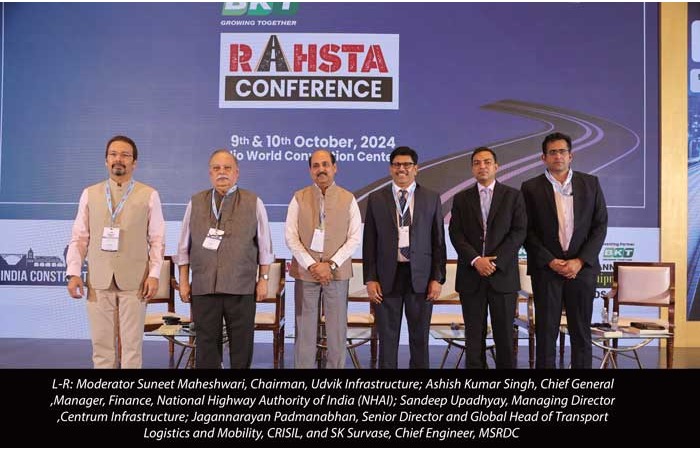
HAM has done wonders to the road sector
The evolution of road infrastructure models has become a focal point in discussions surrounding sustainable development and investment in India. Recent dialogues highlighted the transformative shift from traditional Engineering, Procurement, and Construction (EPC) contracts to more dynamic frameworks such as Build-Operate-Transfer (BOT) and Hybrid Annuity Models (HAM), underscoring the crucial role of the National Highways Authority of India (NHAI) in fostering public-private partnerships that are vital for the country's infrastructure growth. At this point in time, MoRTH and National Highways Authority of India (NHAI) missed their national highway construction targets in six of the past 10 years. Also the government is now looking to reduce its debt to Rs 1 trillion by 2024-25. “We have NHAI, which everyone has been discussing, but it would be interesting to hear the Maharashtra State Road Development Corporation (MSRDC) perspective, given their active involvement in road projects,” said moderator Suneet Maheshwari, Chairman, Udvik Infrastructure, expressing a desire to explore NHAI’s insights on attracting Indian developers back into the sector. He opened the session by highlighting the pivotal role of NHAI and emphasised upon the importance of understanding the current landscape.
HAM: Revolutionising road infrastructure
“HAM, in the last 10 years, has done wonders to the road sector,” said Sandeep Upadhyay, Managing Director, Centrum Infrastructure, about the transformative impact of the Hybrid Annuity Model (HAM) on the road sector over the past decade. “All these EPC companies, which were struggling at one point in time with respect to keeping pace in terms of raising capital, investing, taking the traffic as well as the construction risk at the same time, convincing the bankers, I think found the HAM model very interesting. As the name itself suggests, it's a hybrid,” he said and describing it as a “deferred EPC model,” Upadhyay highlighted its suitability for EPC players, providing a strategic framework that allows for a 15-year operational horizon – an innovative approach that has not only facilitated investment, but also streamlined the process of securing financing from banks, ultimately revitalising the sector.
Balancing HAM, EPC and BOT
“Many of the established road developers who are taking market risks have completely vanished from this particular part of it so it is becoming more an EPC or a deferred EPC game and nobody wants to take a market risk,” said Jagannarayan Padmanabhan, Senior Director and Global Head of Transport, Logistics and Mobility, CRISIL, expressing concerns over the shifting dynamics in the road development sector, noting that many established road developers have retreated from taking market risks. “And that's probably one of the discussion points that we should have on how to bring back that and who can take that kind of a market risk. And there are some people who want to take it, but the enabling environment is a lot more focused towards ham and EPC projects. So that's the somewhat not so good part in terms of the HAM coming through and which has kind of edged out BOT players completely.”
“While the sector has seen successful projects under the Hybrid Annuity Model (HAM) we must also encourage Indian bidders to take on market risks to maintain a competitive landscape,” he asserted, emphasising upon the need for a balanced approach between engineering, procurement and construction (EPC) projects and market-risk-bearing models.
Bidders, finance and equipment
“I have seen the capacity technological capacity being built up there outside in India and that's why I asked that what are the foreign parts there so I saw some equipment which are made in India,” said Ashish Kumar Singh, Chief General Manager of Finance, National Highway Authority of India, acknowledged the increasing presence of domestically manufactured equipment, reflecting a shift towards self-reliance. Singh emphasised that the bidding capacity of contractors is closely linked to their financial capabilities, noting that improved financing options can add substantial value to projects. He commended the efforts of RAHSTA for fostering collaboration and coherence within the ecosystem, which is crucial for enhancing the overall effectiveness and affordability of road construction in the country.
Driving Maharashtra’s infrastructure success
“Right now we are executing Rs 810 billion worth of projects,” said SK Survase, Chief Engineer, MSRDC, adding that a bid has been made for an additional Rs 1,110 billion worth of projects. He revealed that there are projects valued at Rs 1710 billion in the DPR stage, bringing the total project pipeline to an impressive Rs 3 trillion, “for which bankers are ready to fund us.” He expressed confidence in securing funding from bankers, contingent on support from the Government of Maharashtra in terms of equity and bank guarantees. With a solid land bank in place, he emphasised that MSRDC is poised to continue its success in delivering these significant infrastructure projects.
The way ahead
The discussion focused on leveraging 98 per cent of India's roads for infrastructure development, emphasising the shift from EPC to BOT models to enhance quality and sustainability. Even as the Government plans to add 50,000 km of high-speed corridors by 2047, the immense potential for transforming India's road network into valuable assets can be seen from the fact that while national highways comprise only 2 per cent of the country’s total roadways, a staggering 98 per cent of roads present untapped opportunities for monetisation and infrastructure development.


 +91-22-24193000
+91-22-24193000 Subscriber@ASAPPinfoGlobal.com
Subscriber@ASAPPinfoGlobal.com